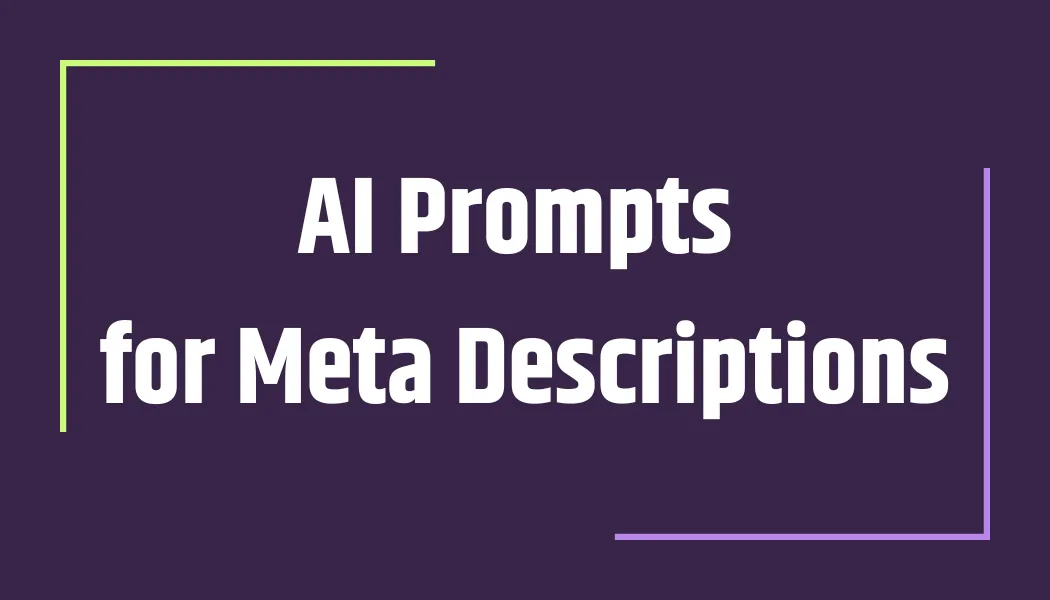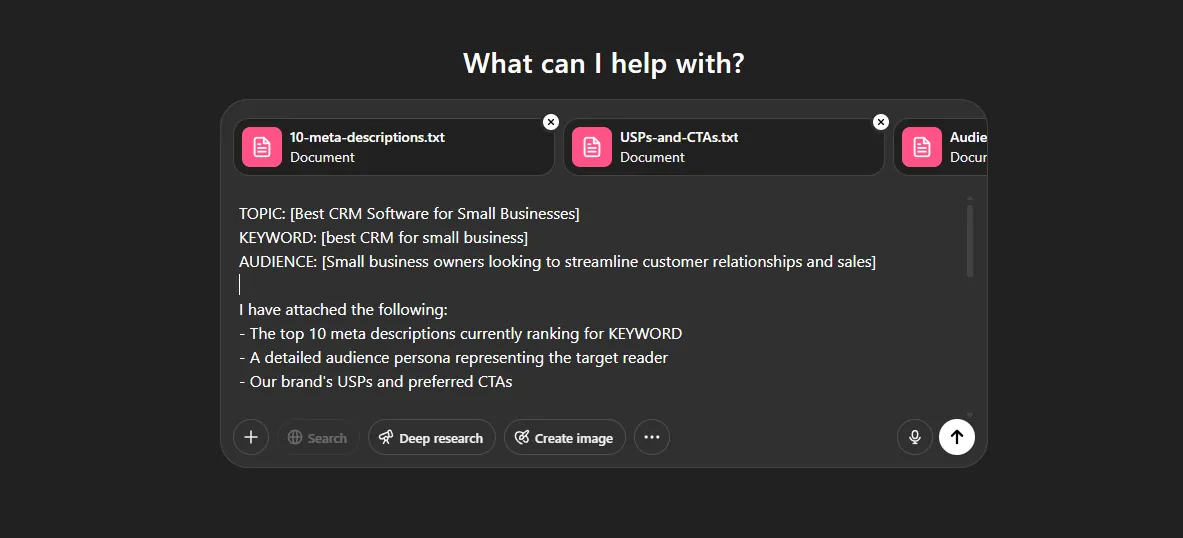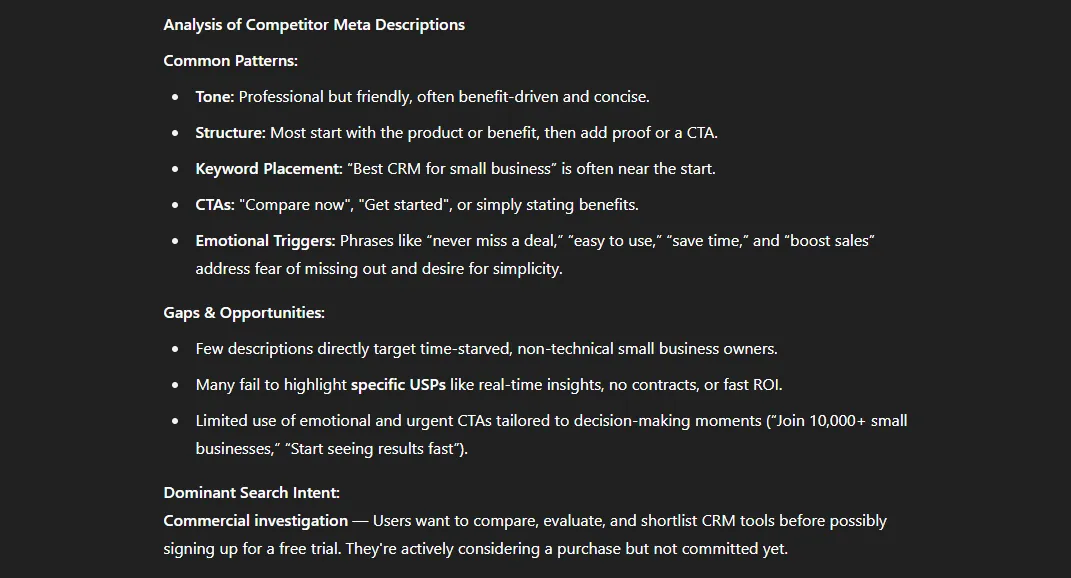AI Meta Description Prompt That Writes for Clicks

Most people use generic AI prompts that generate bland, robotic meta descriptions. This custom prompt forces the AI to think before writing, analyse top competitor snippets, align with search intent, and target your audience with benefit-driven, emotionally resonant language. This results in more engaging, higher-converting meta-descriptions in less time. Copy the prompt, tailor it to your real inputs, and test it for CTR lifts.
Grabbing attention in SERPs is becoming increasingly difficult. Your meta description is a deciding factor for your click-through rate.
Meta descriptions used to be written manually or concatenated using a blanket description. However, if you were willing to put in the effort, you would have an edge over most of your competitors using these lacklustre blanket sitewide descriptions. But now, with the rise of AI, we're seeing a fundamental shift in how meta descriptions are crafted.
The previous goal was to gain an edge over competitors by spending more time testing and crafting each description. However, your competitors can make much more effective descriptions with AI than previously.
Now, we need to find the edge again. This comes in using AI to craft specific meta descriptions and then tweaking them manually. Currently, most people will use a simple prompt to generate a simple meta description, so our edge will be tailoring a prompt to gain an even better output.
The Problem with Generic AI Meta Descriptions
Overuse of Generic or Robotic Phrasing
Using generic prompts to generate a meta description will result in a bland and emotionless description that does not convey your brand. This occurs because AI is defaulted to pull from the most common language patterns related to your query. This means it's pulling its language mainly from the meta descriptions created by lazy SEOs we mentioned earlier.
This generic tone can undercut your brand voice and lower your content's value. Worse, it will also blend into the rest of the descriptions found in the SERPs, reducing your CTR despite high rankings.
AI is only as good as the instructions it's given — and that's why a strategic, well-crafted meta description prompt makes all the difference. With the right prompt, AI stops sounding like a machine and starts writing like a marketer.
Doesn't align with page-specific search intent
One of the biggest flaws in AI without granulated instructions is its inability to match the intent behind a specific page. A blog post aiming to educate needs a meta description that promises answers. A product page should highlight benefits. A landing page for lead generation should tease value and offer a clear CTA.
Without including detailed information about your product or information page, the only output you will receive is "Discover all you need to know about our product. Click to learn more." It doesn't give the user any information or mental activation to make them want to click to see more.
That's why your prompt needs to feed the AI with clear context:
- Who is the page for?
- What action should the user take?
- What makes this page valuable?
The more targeted your prompt is, the more intent-aligned and effective your meta description will be.
Custom AI Meta Description Prompt
TOPIC=[INSERT TOPIC]
AUDIENCE=[INSERT TARGET AUDIENCE]
KEYWORD=[INSERT PRIMARY KEYWORD]
I have attached the following:
- The top 10 meta descriptions currently ranking for KEYWORD
- A detailed audience persona representing the target reader
- Our brand's USPs and preferred CTAs
Analyse the 10 competitor meta descriptions and identify:
- Common patterns in tone, structure, keyword placement, CTAs, and emotional triggers
- Gaps or opportunities to stand out and better satisfy user intent
- The dominant search intent behind KEYWORD (informational, commercial, etc.)
Based on this analysis, write 10 unique, SEO-optimized meta descriptions for KEYWORD that:
- Stay between 140–160 characters (max 1024px width)
- Are unique, not a rewording of existing descriptions
- Clearly communicate what the page offers and why it's valuable
- Speak directly to AUDIENCE, using persuasive, benefit-driven language
- Incorporate 1–2 USPs and one CTA
After writing, briefly explain:
- Provide your output as a numbered list of meta descriptions, with each description on a new line and preceded by its character count in parentheses
- Which user intent does each version address
- Why it may outperform competing snippets in click-through rate (CTR)
How to use this prompt

Gather Your Inputs
- Collect the top 10 competitor meta descriptions for your keyword.
- Define the TOPIC, KEYWORD, and AUDIENCE for your target page.
- Outline your target AUDIENCE persona in a text file.
- List your product/service USPs and preferred CTAs in a text file.
Feed the Prompt to the AI
- Use the structured prompt template.
- Plug in your real data (topic, keyword, audience, USPs, CTAs, URL, and the 10 competitor descriptions).
- Paste the complete prompt into the AI tool of your choosing. (ChatGPT seems to give me the best results currently)
Review the Output
- AI will return 10 meta descriptions for your target keyword and audience.
- It will also explain the user intent each one targets and why it may perform well.
Choose & Refine
- Select the best version.
- Ensure it's within 140–160 characters and compelling at a glance.
- Use a SERP snippet simulator to preview it.
Deploy & Monitor
- Add the final meta description to your web page's HTML
<meta name="description" content="your description">. - Monitor performance in Google Search Console (look at impressions, CTR, etc.).
- Revisit periodically to test newer versions.
Why This Prompt Works
What differentiates this meta description prompt from a generic one is it's structured to think like a marketer before it writes like one.
By feeding AI with the right context, such as:
- User persona
- Dominant search intent
- Emotional triggers
- Tone
- Value proposition
The prompt gets AI to analyse before it generates. That's the game changer.
It Thinks Before It Writes

The prompt doesn't jump straight to the answer. It first asks AI to analyse and reflect. This is where the AI breaks down tone, structure, intent, emotional triggers, and CTAs and acts like a mini-strategy session before it starts writing.
Why does this matter? Because without this internal "thinking" phase, AI tends to default to generic patterns. But when you guide it to evaluate what makes a high-performing meta description work, it generates content that aligns more with human decision-making, user psychology, and SEO best practices.
Optimised for Length, Keywords & CTR Psychology
Each output falls neatly within Google's 150–160 character sweet spot. Keywords such as: "best CRM for small business" are strategically placed toward the beginning, helping boost relevance. At the same time, benefit-driven phrasing and direct calls to action grab attention and drive curiosity, which are critical elements for maximising click-through rates.
Matches Search Intent
The descriptions reflect intent, where users are actively comparing solutions. That's why CTAs like "Compare now," "Try it free," and "Explore features & pricing" work so well. They meet users at the moment of decision making without adding friction.
Includes Emotional & Action-Based Language
Instead of sounding too robotic or corporate, the prompt makes AI use emotional phrases like "say goodbye to overwhelm" or "finally, a CRM designed for busy small business owners." These phrases reduce anxiety and create excitement, both powerful for engagement.
Examples:

Common Mistakes to Avoid
Even the best prompt won't deliver perfection on the first try - and that's okay. AI-generated meta descriptions often need a human touch to refine clarity, tone, and alignment. Too many marketers treat the first output as the final version, missing the chance to fine-tune the language/tone used.
It is a creative partner, not a finished product machine. Let it do the heavy lifting, but always run each description through a human filter:
- Does this speak to our brand voice?
- Is the CTA strong enough?
- Are we using the right emotional triggers?
- What does my ideal reader care about right now?
- What problem are they trying to solve?
- What phrasing or offer will resonate with them?
A quick 30-second edit and live testing can be the difference between "meh" and a click.
AI doesn't know your audience like you do unless you tell it. Your prompt should include context about who you're speaking to. The better you define your audience in the prompt, the more tailored (and effective) the meta description will be.
Final Thoughts
AI can't replace great marketing but can supercharge your execution and time. This custom prompt is designed to bridge the gap between automation and authenticity. It gives you speed and precise descriptions, helping you create meta descriptions that drive clicks through higher CTRs.
Copy the prompt, customise it to your page's topic and audience, and see what it delivers. Even better, A/B test a few variations and tracks how your click-through rates respond.
If you use the prompt and make any edits/improvements, let me know via X (Twitter), LinkedIn, or email.
Key Takeaways
- Generic AI prompts often produce vague, emotionless meta descriptions that hurt click-through rates.
- Your meta description is a major CTR lever and deserves more than a one-line prompt.
- This custom prompt includes context such as search intent, audience persona, competitor analysis, and USPs, forcing the AI to "think before it writes."
- The prompt helps generate 10 unique, SEO-optimized meta descriptions that are clear, persuasive, and aligned with your brand tone.
- It works because it's built for marketers — focusing on keywords, emotional triggers, action-based CTAs, and length constraints.
- Minor edits still matter — refining output ensures your final description is aligned with your brand and audience.
- You can A/B test the outputs and monitor CTRs via Google Search Console to improve over time.
